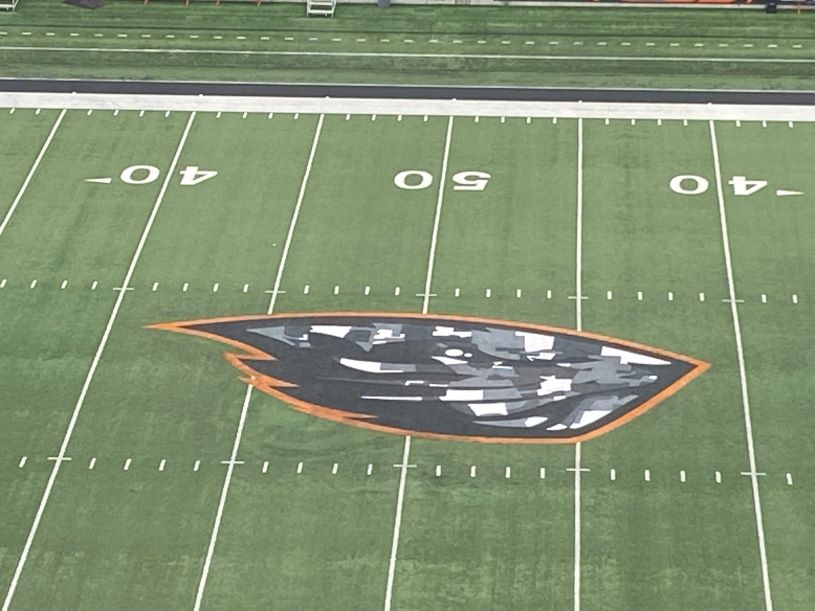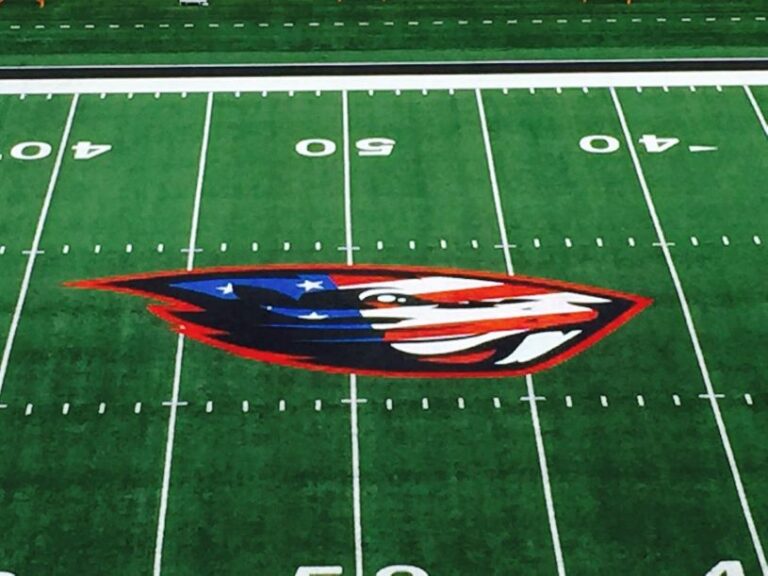By Mike Hebrard
With constant branding, rebranding and social media, the need for adding or changing logos on athletic fields is a revolving door. Technology has come a long way from chalking lines and designs on the old mat-style synthetic fields by adding yellow iron oxide to white chalk and simply washing it off with a hose or pressure washer.
With the advent of infill fields, a better application and removal was needed so as not to build up the chalk layer. The Seattle Seahawks, for example, had an all-green field and were using regular grass paint to paint lines, numbers and logos and then would power wash it off to convert to soccer. But the constant wet weather in the Pacific Northwest and the buildup of paint didn’t make for a very clean product.
A local stain company, Eco Chemical, was asked to assist, as they dealt with resins and had developed a paint that would reliquefy with the application of a nontoxic remover solution. Through experimentation, lab testing and on-field application with the Seahawks, a paint was created to be applied and removed by adding the remover that would soften the paint and be allowed to scrub and washed through the draining system. Then a highly specialized machine was used to extract the paint particles and vacuum the surface. With the design of the paint, water and rain would not wash out the paint – making it last for several events.
There are currently several NFL fields that are all-green turf, while others have endzones and midfield logo areas that are painted and removed in a weekly or game-scheduled fashion.
When Oregon State University (OSU) decided to replace its field, OSU had not yet released its new branding. I painted the endzones with the old font and the Angry Beaver logo in the center of the field. Due to the wear on the middle of the field, a temporary tent was brought in to protect from wet conditions and repaint the logo. Once the new branding was done, the next year permanent paint was applied for the endzone lettering, but the new midfield logo was painted with a temporary paint until a new inlaid logo was made. Then OSU marketing got involved and requested a red, white and blue design be painted in the new beaver logo to recognize our military for Veterans Day. They sold more than 5,000 t-shirts that week with the patriotic logo I painted.
With the great success of the patriotic logo, OSU requested designs for other events. Keeping with the military tradition, OSU decided on a digi-camo effect on the orange portion of the logo, requiring me to freehand the pattern (the shapes were actually renditions of the counties in Oregon). For Breast Cancer Awareness week, I outlined the endzone letters in pink. Wanting to bring back some past history, OSU brought back Retro Bennie, a lovable character that had to go through some dismal years of Oregon State football. Fans loved the seasonal addition of Bennie – usually for homecoming week. The Bennie logo is a bit narrower than the new beaver logo and a bit higher, so a removable turf green paint is added to the exposed inlaid logo.

There is a very limited color selection of removable paint in aerosol cans, so liquid paint needed to be used for custom colors. Bennie has black, white, orange and turf green as the required colors, but a custom liquid brown is needed for the main portion of the logo. If weather and time permit, a clear base can be added to the turf in both liquid and aerosol form to ease removal and keep paint from getting too deep in the fibers.
It is harder to keep paint on for an extended time if the field is new, as it usually has a UV coating to add to the wear. When a field gets older, paint tends to stack on the fibers better, but is usually harder to remove. It usually takes three to five hours to paint a midfield logo or three to four hours overall with a couple helpers.
I typically head back the following week to remove the painted logo by spraying the remover on the painted portion of the logo, scrubbing with a deck brush, and lightly pressure washing the paint into the drain system. It is a lot of work by hand, but I don’t do enough painting of temporary lines and logos to warrant purchasing a remover machine.
With the help of my friend, Perry Petraquin, on the machine I use for laser grading, we installed an engine with pressure washer and scrub brushes that are powered by the hydraulic PTO (and we added nozzles in front and behind the brushes). I can also add pressure to the brushes with the up-and-down front control lever. We added a 20-gallon tank to the back of the machine. Not getting the flow of water needed to charge the pressure washer pump, we added a ShURflo pump to keep the system charged. Sometimes I add buffer pads on the bottom of the scrub brushes to apply the remover more effectively. This machine works great for removing lines, as the combination of the two brushes is only about 15 inches.
With the amount of bowl games and related sponsors, more college teams are turning to temporary logos. Some NFL fields are completely green with everything you see being painted, even the lines. Some fields have blank endzones and middle of the field so they can paint logos for special games and other events. In some cases, there will be a game on Saturday, with paint removed at night and then the field repainted for the Sunday game.
Technology has come a long way from power washing chalk and paint markings from non-infilled turf. The turnaround is amazing, but does require a lot of planning and additional labor. For an outdoor stadium, tents are usually needed to keep the turf dry and to allow the paint to dry as well. Blowers and heaters can help with the drying process, but be sure to protect the turf from the heated blower by placing blowers on plywood to prevent them from melting the turf.
Mike Hebrard is the owner/operator of Athletic Field Design, a leader in athletic field design, maintenance and customized graphics. He is an industry consultant and a frequent public speaker at industry events. For more information, visit www.athleticfield.com.


